soziale stadt - bundestransferstelle
besonderem Entwicklungsbedarf - Soziale Stadt"
Kassel Nordstadt |
|||||||
|
Christine Mussel |
|||||||
1. Nature of the Area 
The model area "Kassel-Nordstadt" is a typical heavily built-up, densely populated urban district, which suffers from considerable shortcomings in social structure, the condition of buildings, the availability of work, education levels, the social and local cultural infrastructure, and the quality of dwellings, the residential environs, and the environment. Selective migration processes and disinvestment threaten the district with social decline.
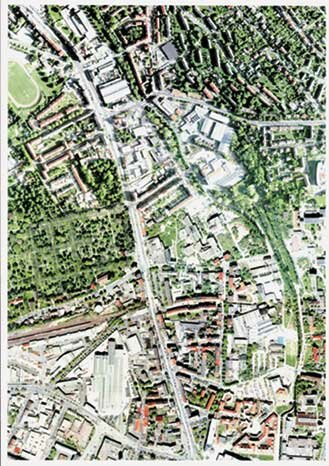 |
Kassel-Nordstadt (Source: Municipal Labour Promotion, Kassel Municipality) |
|
The Kassel-Nordstadt district was built during the mid-19th century industrialisation period as an industrial suburb with workers' housing. Over subsequent decades housing estates were built, company welfare and educational institutions established for the growing number of workers at, for example, the Henschel works. The bombing of the armaments city Kassel in 1943 razed both the old city and a large part of Nordstadt. Reconstruction in the district after 1945 concentrated primarily on commercial and industrial enterprises. Since little new housing were built, the population of the district fell during the 1950s and 1960s. Economic structural change in the 1960s triggered a wave of plant closures and disinvestment, leaving derelict sites in the inner city. The sale of former company housing led to speculation, and deprived areas developed. Nordstadt began to attract migrants, so that the district now has the highest proportion of foreign residents in Kassel in both absolute and relative terms. The number of children and adolescents has accordingly increased at a higher than average rate. Segregation processes have given the district a negative image. |
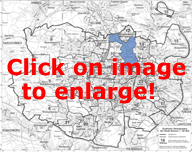 |
Location of Nordstadt within Kassel (Source: Municipal Labour Promotion, Kassel Municipality) |
Development in the neighbourhood dates from different periods. Apart from late nineteenth-century perimeter block development there social-welfare housing and estates from the 1920s and 1930s and from the post-war period. Much of the stock is in need of repair and rehabilitation. The usually larger foreign families often live in cramped conditions in flats that are far too small. The inadequate open spaces and the lack of sports facilities and playgrounds exacerbate the situation.
The extension of Kassel University on the site of the former Henschel works that has been developed since 1978 has gradually stabilised the surrounding area without triggering the feared displacement. The new copyshops, computer stores, bookstores and supermarkets, the cafés and pubs, and the students themselves have brought life into the district. However, development has been stimulated only in a small area in southern Nordstadt and a specific segment of the labour market. The university offers almost no work for the unskilled Nordstadt residents.
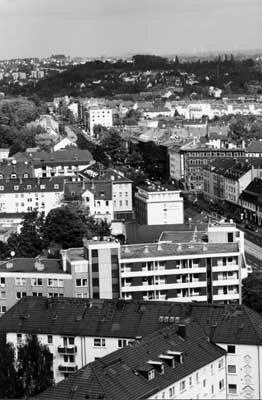 |
View of Nordstadt (Source: District newspaper NORDWIND) |
2. Main Problems and Development Potential 
Typically for districts with special development needs, social, urban planning, and economic problems mesh in the district. Although serious, the problems can offer potential for development, which, however, needs external intervention if it is to be realised.
 |
Migrant firms as development potential (Source: Dialogistic Planning Working Group , Kassel University) |
In several neighbourhoods of Kassel-Nordstadt there is a concentration of migrant households, unemployment, people with low educational and vocational qualifications, and households dependent on state transfer payments. The juvenile delinquency rate is also higher than average. Selective relocation reinforces the imbalance in social structure. This development is due partly to the unfavourable housing structure and deficient environmental conditions, but it is primarily caused by overall structural change in society. The main task must be to breach the "culture of dependence" and, in particular, to improve opportunities for children and young people.
The juxtaposition of residential neighbourhoods with inadequate open spaces and underused industrial land, together with the lack of urban space quality, especially along the strongly divisive traffic axes, intensifies the social declassing of the people who live in the area. This community planning problem, which has been subject to discussion for many years, requires appropriate intervention to improve the quality of life in the district and reduce declassing.
Where public spaces show signs of dilapidation, a sense of insecurity and threat spreads in the district. However, dilapidation in the dwelling environment, in playgrounds and recreational areas can - as examples have shown - provide the occasion for resident collaboration and self-organisation if support is forthcoming from housing developers and other actors.
 |
Arterial road B7 with a highly divisive impact (Source: Dialogistic Planning Working Group, Kassel University) |
Derelict land presents an urban planning and economic problem. But the district also offers interesting sites for conversion to improve the supply of commercial and industrial land or for other, new uses.
Demography and Social Space
|
Nordstadt |
Kassel |
|
|
Size |
352 ha |
10 677 ha |
|
Population (2001) |
14 250 |
194 766 |
|
Population decline (2000–2001) |
3.9 % |
0.7 % |
|
Average household size (1999) |
1.96 pers. |
1.94 pers. |
|
Number of dwellings (1999) |
7 722 |
100 510 |
|
Vacant dwelling units |
n.a. |
n.a. |
|
Housing benefit recipients |
n.a. |
n.a. |
|
Unemployment rate (2001) |
25.8 % |
14.0 % |
|
Social assistance recipients (2001) |
23.0 % |
9.9 % |
|
Foreign population (2001) |
43.1 % |
13.7 % |
|
Population under 20 (2001) |
23.7 % |
19.0 % |
|
Population 60 and older (2001) |
15.9 % |
25.4 % |
The many migrant resident firms and organisations offer potential for the socio-economic and cultural development of the district if appropriately supported.
Finally, the employment and networking structures established under the integrated plan of action since 1997 constitute social capital that can at present be described only by citing examples. They include the university, the wide range of municipal services available in Philipp Scheidemann House, the training opportunities offered by the vocational school centre, the Schlachthof Cultural Centre, and many other club and self-help structures. The district management and the "Nordstadt Project" round table offer an organisational structure for civic engagement and local partnerships in the district. It is already apparent that projects initiated in the framework of the "Nordstadt Project" can engender more sustained, self-organised structures.
3. Development Goals and Focal Points of Action 
The proposal for an integrated plan of action for Kassel-Nordstadt came not - as in many other cities - from the building authorities but from the Department for Labour Promotion, Women's, Health and Social Affairs. To deal with the concentration of social and structural/spatial problems in Kassel-Nordstadt, the competent head of department called for a "paradigmatic shift in urban policy." Interdepartmental and departmental procedures were to generate synergies, the administration was to consider itself a "services enterprise." The involvement of active residents and cooperation partners in the district was to bring tangible success and reverse social exclusion. An important argument was also the increase in mandatory municipal expenditures (Caroli, May 1997) (1).
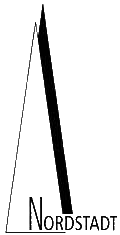 |
Logo of the Nordstadt Project |
The areas of action in social and resident-oriented district development in the Nordstadt Project are:
- child and youth policy,
- social planning,
- employment and training,
- urban planning/neighbourhood improvement,
- promotion of economic development,
- ecology.
The following strategies aim to attain the objectives in these areas of action:
- interlinkage of structural and labour market policy as well as planning and social policy in the district,
- reorganisation of municipal process and administration management,
- coordination of participatory planning and project management methods with community-oriented social work,
- networking the various local actors,
- strengthening residents' self-help and personal initiative,
- promoting the local economy.
The outcomes of the Nordstadt Project over the past four years show that children, adolescents and young adults and migrants have been the main target groups of most projects and measures.
Many projects and measures also focus on urban planning/neighbourhood improvements designed to ameliorate living conditions in specific neighbourhoods. Local residents take direct notice of these activities, which offer a wide range of possibilities for participation and activation.
Most projects in Nordstadt aim to improve the situation of the district as a whole, e.g., the extension of Nordstadt Park, the renaturalisation of the river Ahna, employment and qualification measures, and the development of the "Niedervellmarer Straße Development Plan" to convert a mixed industrial/residential area. These projects addressing the entire district can help enhance the attractiveness of the district as a whole.
Fundamental improvement requires a longer-term process and more intensive action in the field of economic promotion, which has so far not been a main focus of the Nordstadt Project. Promotion of the local economy is therefore one of the major concerns of the local programme support. Following two district discussions and a conference on this subject, a concept for a "service point for employment and economic development" was elaborated in 2001 in collaboration with the relevant economic organisations and institutions. The private "Schlachthof Cultural Centre" is currently developing a project on management consulting and further education funded by the EU Community Initiative URBAN II.
4. Key Projects 
Of the many projects that have been undertaken in recent years in Kassel-Nordstadt, we present one forward-looking example of the integrated action approach and the development of local partnerships: the "North District Floor" ("Stadtteiletage Nord") project.
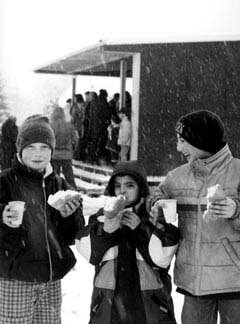 |
Opening of the mobile shelter for children and young people (Source: District newspaper NORDWIND) |
"North District Floor" is a joint project of municipal authorities and private institutions. It is just about to be launched. From the spring of 2002 the municipal child welfare office, the "Schlachthof Cultural Centre," the training organisation "BuntStift", and the private organisation for youth, social, and educational work "Internationaler Bund/IB Kassel" will be jointly offering recreational, training, and educational services on the district floor for children, adolescents, and young adults in the northern neighbourhoods of the district. The second floor of a former office block is being converted for this purpose, and, once work is completed, it will offer group and conference rooms, a computer course room, and a training area for the already successful "Boxing Camp." Social services will supplement the facilities on offer. The municipal child welfare office will be relocating some of its services here.
The child welfare office and the private institutions will be jointly responsible for organising the district floor, planning and interlinking the facilities. It has been possible to finance and realise the project through cross-authority action and the initiative of the private organisations with which the municipality cooperates closely.
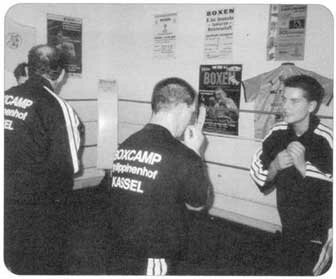 |
Boxing camp on the North District Floor (Source: District newspaper NORDWIND) |
Existing employment and qualification schemes in the district ("Galama," "BuntStift," and "Jafka") are already participating in the conversion and expansion project. In this phase, there is close cooperation with the Kassel social services department, the municipal employment promotion company Kommunale Arbeitsförderung gGmbH, the employment office, and the youth career assistance organisations. For 2001 to 2006 the project will receive further funding from the EU Community Initiative URBAN II. The use of funds from the Federal-Länder programme and from URBAN II requires coordination between the Departments for Urban Development and Building, Environment and Transport, the Department for Labour Promotion, Women, Health and Social Affairs, and the Department for Law and Order, Youth and Sport. For service and facility planning from 2004, the three private institutions have established a fund to accrue a joint reserve.
The project was not planned at the negotiating table; it is the outcome of practical work within the working and networking structures that have developed over recent years in the Nordstadt Project. A two-year run-up period and intensive public relations work, including the participation of children and young people, was needed to develop the project.
The contributing organisations with the facilities and services planned for the "North District Floor."
Stadt Kassel, Jugendamt:
- Koordination Nordverbund: Development of appropriate services and facilities and the further development of the framework plan for child and youth promotion; Administrative and technical supervision of municipal staff; Development and promotion of cooperation with private and other institutions in the district.
- Mobile Clique Support
- Management of the District Floor
Kulturzentrum Schlachthof:
- Xenos Project: Get Fit/Girls Against the Right: Vocational and occupational field orientation; Occupational counselling, application training; Computer and Internet courses; Creativity workshops; Antiracism and de-escalation training.
BuntStift:
- Voluntary Social Training Year: Occupational orientation and training for young people; Acquisition of key qualifications; Support and advice.
Internationaler Bund (IB):
- Boxing Camp: Fitness and jogging/boxing; Counselling and violence prevention.
- Intercultural district management in youth affairs: Improvement of services and facilities for migrants; Opening of the joint youth programme for young people from a migrant background.
The overview "Projects and Participants in the Nordstadt Project" provides broad information on all the projects undertaken in the context of the integrated and resident-oriented approach. The district management of the Kassel Department of Employment Promotion (Dept. V) is participating in all the projects mentioned.
 |
Projects and Participants in the Nordstadt Project |
5. Organisation and Management 
At the administrative level, overall control of the Nordstadt Project is in the hands of Department V (Employment Promotion, Women, Social Affairs, and Health) of the Kassel municipality. A cross-departmental steering group sets priorities for individual projects depending on the annually updated scheduling and planning of funding requirements. All municipal departments are involved and, where represented in projects, various relevant administrative units. In making decisions, the steering group takes account of the recommendations put forward by the municipal project development group, a body at the chief officer and specialised section level. Both bodies take account of the consultations and recommendations of the Nordstadt Project Round Table. The round table is a forum for the exchange of information on planned and implemented activities and projects in the district, and is the interface between the projects and the actors in the district. Owing to its composition, it is largely a body of experts.
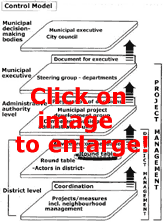 |
Nordstadt Project control model (Source: Municipal Labour Promotion, Kassel Municipality) |
The coordinating office for the Nordstadt Project includes the project management and the district management, and is located at the Kommunalen Arbeitsförderung gGmbH (KAF), a public welfare float-off. The local contact person in the district is a Workers' Welfare Organisation (AWO) neighbourhood manager in the district centre. With this construction, the functions of "neighbourhood management," a term that has not yet been given a generally accepted definition, have been distributed over three levels for the Kassel Nordstadt Project (see the overview: "Allocation of neighbourhood management functions in the Nordstadt Project").
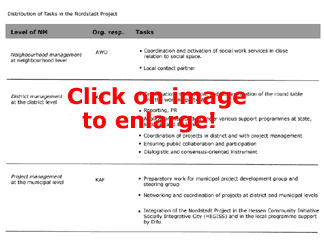 |
Allocation of neighbourhood management responsibilities in the Nordstadt Project |
6. Activation, Participation, and Public Relations 
The local population in Nordstadt is multiethnic (from 29 nations) and the majority of residents belong to the lower strata of society. Such a mixed population will accept opportunities to participate only if they are adapted to their immediate needs, are practical for everyday purposes, and are personally mediated. Outreach surveys, ad hoc counselling, streetwork, appreciable activities, and other activation techniques are suitable to this end. Such direct forms of participation and activation have been put into practice in Kassel-Nordstadt in many ways for a considerable period. They contrast with representative and intermediary forms of participation, which require longer-term engagement, verbal assertiveness, and the interest and ability to process relatively abstract subjects. Conferences and round tables are examples of such forms of participation, which attract primarily the representatives of civic action groups, associations, private sponsoring organisations, and other local actors. This form of representative or intermediary participation also exists in Kassel-Nordstadt.
 |
Members of the Nordstadt Project Round Table (Source: Dialogistic Planning Working Group, Kassel University) |
The conceptual orientation framework for direct and for representative/intermediary participation in Kassel-Nordstadt is a four-phase plan comprising the following elements:
- information through public relations,
- citizen participation through community-oriented social and youth work,
- district-oriented employment and qualification schemes, and
- district management.
Participation and activation fulfil their purpose if the neighbourhood population can influence decisions that affect them and/or are encouraged to settle their concerns themselves.
In this regard, the Nordstadt Round Table is the most important representative form of participation. It has been meeting regularly since 1997 at two-weekly intervals, and has managed with astounding continuity to assemble representatives of facilities, institutions, and advisory councils. Even if, from the point of view of the round table, not all relevant actors yet collaborate, this body nevertheless performs an important function in exchanging information, in preparing decisions on projects and measures in the Nordstadt Project, and in networking activities.
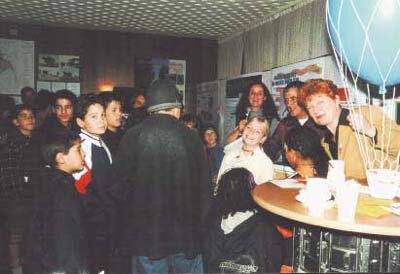 |
Nordstadt Project festival 2001 (Source: Dialogistic Plannung Working Group, Kassel University) |
Direct resident participation that goes beyond the activation of individuals is target-group specific. Children and adolescents participated in the planning for the mobile clique centre (e.g., March 2001) - in a Univision film by Kassel University, the young people reported on their situation and their contribution to the realisation of the shelter; at a prospects workshop other children and adolescents developed ideas for the "Nordstadt Park," and marked traffic lanes to accustom motorists to changes in traffic rules. In one Nordstadt neighbourhood a tenants' association is now operating, in another a tenants' initiative has formed. Both participate in the round table. Important instruments for strengthening autonomy and developing self-organisation structures are the now highly diverse circles for young people and women. They are supported by non-profit organisations, housing companies, and the tenants' association. Employment and qualification projects, the voluntary social training year, and other measures that involve young people in peer-group contexts and useful projects for the purpose of individual qualification are examples for individual participation and activation. Direct participation by Nordstadt residents requires multipliers in intermediary facilities and organisations, who have been successful in their efforts in Kassel-Nordstadt.
Sustained structures have now developed for area-related public relations. Since 1999, a free district magazine "Nordwind" has been appearing regularly every three months, published by the Kassel University "Nordstadt Workshop." With numerous contributions from groups, associations, and individual residents - partly in Turkish - Nordwind has become a professionally produced district forum and activation tool. Every year the district management puts out the "Nordstadt Projekt Spiegel," which reports on the status of the project and its prospects. Also once a year, a district conference is staged, now under the name "Nordstadt Project Festival," which provides a broad framework for information and exchanges. An entertainment and motivating programme supplements the informative component. Public relations that reaches beyond the district makes use primarily of the local daily newspaper. An analysis of about 60 articles on the Nordstadt Project (1997-2001) shows that the citywide public is informed above all about individual projects for the target group "youth." Background articles tend to be rare. In the opinion of Nordstadt Project actors, public relations work should be intensified both within the district and citywide.
7. |
Conclusion: The Acid Test has been Passed - The Goal Remains the Development of Self-Sustaining Structures
|
Kassel-Nordstadt is a district with special development needs primarily because of the extraordinary concentration of social and urban planning problems in this area. Indicators include unemployment, dependence on social assistance, shortcomings in housing and the dwelling environment. Urban planning no longer hopes to solve social structure problems by distributing poverty across the city ("dispersion" and "social mix"). With the support of the federal and state governments, municipalities and private organisations must tackle the problems themselves, i.e., on a small scale and in custom-made projects and measures. They need the help of local actors and of the people affected.
The main target groups for measures in Kassel-Nordstadt are children and young people, as well as people without German nationality together with their children and grandchildren. These groups constitute a higher than average proportion of the Kassel-Nordstadt population. Integrative intervention is also urgently needed in the district to stop continuing segregation owing to the high rate of outmigration, for higher-income households are moving out, leaving their poorer neighbours behind ("selective mobility").
A provisional appraisal - no more is possible at this point in time - shows that projects and measures concentrate primarily on the target groups mentioned. Working and participation structures are in place that have passed the first acid test in four or even more years of activity. This is to be seen as positive. But is it enough? Is it more than a drop in the ocean? The question must remain unanswered for the moment. However, it can be said that the stabilisation of the district will depend essentially on whether we as a society recognise that the urbanity of our cities is shaped by immigration; and there is convincing evidence that we will continue to need "strangers" ("the shrinking city"). On the basis of this positive attitude, immigrants - in Kassel-Nordstadt people from 29 nations and cultures - must be given the necessary scope for personal development. This is the precondition for their identification with the district and for "enterprising" action. If such a path is taken it will affect cultural, social, and economic life and will have an impact on the aesthetics of the neighbourhood. This is likely to be the greatest challenge for all concerned, for recognition of the "stranger" is associated with many fears and difficulties. However, these problems cannot be solved at the district level alone, the whole of society must address the issue.
Refernces
(1) Ilona Caroli, Sozial- und bewohnerorientiertes Stadtteil-Entwicklungskonzept Nordstadt (Magistrat der Stadt Kassel, Dezernat für Soziales, Schule und Gesundheit; unveröffentlicht), 1997. ![]()
Im Auftrag des BMVBS vertreten durch das BBR. Zuletzt geändert am 25.05.2005